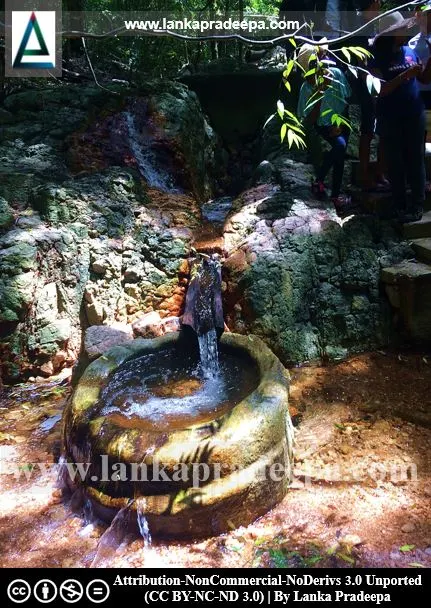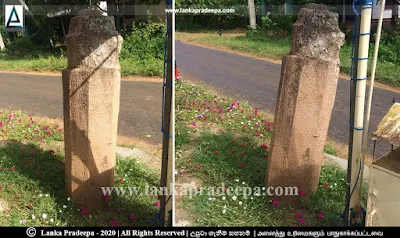
Jathika Namal Uyana or National Ironwood Garden (Sinhala: ජාතික නාමල් උයන රෝස තිරිවාණ නිධිය) is a famous ironwood forest and a large rose quartz mountain [about 320 m (1,049.87 ft. amsl)] situated in the village of Ulpathgama at Galkiriyagama in Anuradhapura District, Sri Lanka. The site which was developed under the direction of Vanavasi Rahula Thera is presently maintained under the authority of the Central Cultural Fund.
The site
The Jathika Namal Uyana is situated in the Highland Series of crystalline rocks close to the Vijayan-Highland Boundary (Mahinda, 2002). The exposed rose quartz deposit which is estimated to be over five hundred million years old is believed to be the largest one of its kind found in the South Asian region (Mahinda, 2002' Wickramaratne & Ranawana, 2002). The site receives the dichotomous climate conditions of dryness associated with the Dry Zone and wet weather associated with the Wet Zone. However, the area including the Jathika Namal Uyana belongs to the Tropical Lowland Seasonal Rain Forest (Mahinda, 2002).
The site is totally extending into an area of about 1,200 hectares and a portion of about 105 hectares near its northern boundary has a lushly grown Na-tree (Mesua ferrea) grove (Mahinda, 2002; Wickramaratne & Ranawana, 2002). Some suggest that this Na grove could be a horticultural garden with historical value (Mahinda, 2002; Wickramaratne & Ranawana, 2002). Several ancient buildings and monuments belonging to a Buddhist monastery or a similar complex are found scattered in an area of about 24 hectares located within this Na grove (Wickramaratne & Ranawana, 2002).
Archaeological monuments
A number of archaeological monuments are found at the southwest boundary of the Namal Uyana forest reserve. They include the ruins of a Stupa, a Bodhighara, an Uposathagara, an image house, an Asanaghara, other building foundations and rock-cut steps etc. Besides that, an "Attani Kanuwa" known as the "Ranawa Pillar Inscription" is located on the road in front of the Ranawa Devurada Ranrada Viharaya premises, a Buddhist temple site situated in close proximity to the Jathika Namal Uyana. The inscription which is dated to the reign of King Dappula IV (923-935 A.D.) records a decree granting certain immunities in respect of twelve Payalas of lands in a village named Rana [(modern Ranava village) Ranawella, 2004]. According to the inscription, it is prohibited to cut down the trees such as Palmyra-palms and Mi within this particular area and to arrest those who may come into this village after having committed murder outside (Ranawella, 2004). [Note: Many have misidentified this inscription with the Andiyagala Pillar Inscription of King Udaya II (887-898 A.D.).]
Some identify the Ranawa Inscription as a record that mentions a kind of sanctuary that existed in the 10th century. As it is located very close
to the Jathika Namal Uyana, some believe that this sanctuary may have
had a connection with it in the past.
Namal Seya Stupa
The ancient Stupa which has been built on a square-shaped terrace is completely conserved. The terrace is about 4-5 feet tall from the ground level and can be accessed through four entrances. The Sandakada Pahana (the moonstone) is visible at each entrance.
Bodhigharaya
Although there is no Bo tree today, the Bodhighara or Bodhi tree shrine at Jathika Namal Uyana provides evidence of the presence of a Bo tree in the past. The outer parapet of the Bodhighara which makes a square-shaped terrace is built of rose quartz. From the available archaeological evidence, this ancient structure is said to be a work belonging to the 8th century A.D.
Padhanagharaya
During the latter part of the Anuradhapura Period, Padhanagharas became popular and were built in several places in Sri Lanka (such as Arankele, Ritigala, Batahirarama, and Veherabendigala) to accommodate the Buddhist monks who devoted themselves to meditation. A number of cubicles known as Padhanaghara are found in the Jathika Namal Uyana premises.
Gal Pathraya & Gal Pahana
A stone begging bowl (Gal Pathraya) type implement can be seen at the bottom of the rose quartz outcrop collecting the water flowing down from the mountain. Also, a stone lamp (Gal Pahana) with eight wick holders has been found at the site.
A protected site
- An area of 24.111 hectares within the Jathika Namal Uyana was designated as an archaeological reserve on 12 November 2001, by a Gazette notification No. LDB 277/40 (Mahinda, 2002).
- The Ranawa mountain or Namal Uyana was declared as a protected forest on 26 April 2005, by an Extraordinary Gazette notification no. 138/137.




.
Do you know
References
1) Mahinda, W., 2002. A Preliminary Archaeological Study of the Jatika Namal Uyana. Annual Research Sessions, University of Peradeniya, Sri Lanka. Vol. 7. p.45.
2) Ranawella, G.S., 2004. Inscription of Ceylon. Volume V, Part II. Department of Archaeology. pp.98-103.
3) Wickramaratne, S.N. and Ranawana, K.B., 2002. A Preliminary Ecological Survey of the Jatika Namal Uyana, Galkiriyagama. Annual Research Sessions, University of Peradeniya, Sri Lanka. Vol. 7. p.44.
Location Map
This page was last updated on 30 July 2023
A short note for local school students
ජාතික නාමල් උයන
ජාතික නාමල් උයන ශ්රී ලංකාවේ අනුරාධපුර දිස්ත්රික්කයේ ගල්කිරියාගම උල්පත්ගම ගම්මානයේ පිහිටි ප්රචලිත නා අරණක් සහ විශාල රෝස තිරිවාණ කන්දක් වේ. වනවාසී රාහුල තෙරුන් යටතේ සංවර්ධනය කරනු ලැබූ මෙම භූමිය වර්තමානයේදී මධ්යම සංස්කෘතික අරමුදල යටතේ පාලනය වේ.
භූමි ප්රදේශයවිජයාන්-හයිලන්ඩ් මායිමට ආසන්නව හයිලන්ඩ් සංකීර්ණය තුල ජාතික නාමල් උයන පිහිටා තිබේ. වසර මිලියන පන්සියයකට වඩා පැරණි යැයි තක්සේරු කෙරෙන මෙම භූමි ප්රදේශයෙන් මතුව ඇති රෝස තිරිවාණ නිධිය දකුණු ආසියා කලාපයෙන් හමුවන මේ වර්ගයේ විශාලතම නිධිය ලෙස විශ්වාස කෙරේ. වියලි කලාපීය ශුෂ්ක හා තෙත් කලාපීය වැසි යන දෙවර්ගයටම අයත් කාලගුණ තත්වයන් මෙම ප්රදේශයට හිමිය. කෙසේනමුදු, ජාතික නාමල් උයන ඇතුලත් මෙම ප්රදේශය නිවර්තන පහත්බිම් සෘතුමය වැසි වනාන්තර දේශගුණික කලාපයට අයත් වේ.
හෙක්ට්යාර 1200ක පමණ වපසරියක පැතිරී පවතින මෙම භූමි ප්රදේශයේ උතුරු මායිමට ආසන්න හෙක්ට්යාර 105ක පමණ කොටසක ඉතා හොඳින් වැඩුනු නා ගස් ගොන්නක්/ නා අරණක් වේ. මෙය ඵෙතිහාසික වටිනාකමකින් යුත් උයන් වගාවක් විය හැකි බව සමහරුන්ගේ මතයයි. බෞද්ධ විහාරයකට හෝ එවැනි සංකීර්ණයකට අයත්වන පුරාණ ඉදිකිරීම් හා ස්මාරක ප්රමාණයක් මෙම නා අරණ තුල හෙක්ට්යාර 24ක පමණ වපසරියකින් යුතු භූමි භාගයක විසිරී පවතී.
පුරාවිද්යා ස්මාරකනාමල් උයන වන රක්ෂිතයෙහි නිරිතදිග මායිම් කොටස තුල පුරාවිද්යා ස්මාරක ප්රමාණයක් හමුවේ. ස්තූපයක, බෝධිඝරයක, උපෝසතාඝාරයක, ගොඩනැගිලි වල පාදම් හා ශිලා පඩිපෙළ ආදී නටඹුන් ඒවාට ඇතුලත්ය. මේ හැරුණුවිට, ජාතික නාමල් උයනට ආසන්නව පිහිටි බෞද්ධ විහාරයක් වූ රණාව දෙව්රද රන්රද විහාරය අසල මාර්ගය මධ්යයේ අශ්ඨාකාර අත්තාණි කණුවක් (ටැම් ලිපියක්) ස්ථාපනය කොට තිබේ.
නාමල් සෑය ස්තූපයචතුරස්රාකාර මළුවක් මත ඉදිකොට තිබෙන පුරාණ ස්තූපය සම්පූර්ණයෙන් සංරක්ෂණය කොට තිබේ. මළුව පොළව මට්ටමේ සිට අඩි 4-5ක් පමණ උසින් පිහිටන අතර ප්රවිශ්ඨයන් හතරක් ඔස්සේ ඊටපිවිසිය හැක. එක් එක් ප්රවිශ්ඨය පාමුල සඳකඩ පහණ බැගින් දැකගත හැක.
බෝධිඝරයඅද වන විට බෝ ගසක් නොපැවතියද, අතීතයේ මෙහි බෝ ගසක් පැවති බවට සාක්ෂි බෝධිඝරය මගින් සපයයි. චතුරස්රාකාර මළුව තනන බෝධිඝරයෙහි පිටත පවුර රෝස තිරිවාණයෙන් නිර්මිතය. දැකිය හැකි පුරාවිද්යා සාධක අනූව මෙම පුරාණ ඉදිකිරීම ක්රි.ව. 8වන සියවසට අයත් යැයි පැවසෙයි.
පධානඝරයඅනුරාධපුර යුගයේ අගභාගය වන විට ජනප්රිය වූ පධානඝර භාවනායෝගී බෞද්ධ භික්ෂූන්ගේ භාවිතය පිණිස ශ්රී ලංකාවේ සමහර ස්ථානයන්හී (අරංකැලේ, රිටිගල, බටහිරාරාම, වෙහෙරබැඳිගල වැනි) ඉදිකෙරිණි. මෙවැනි පධානඝර ප්රමාණයක් ජාතික නාමල් උයන පරිශ්රයෙන්ද හමුවේ.
ගල් පාත්රයතිරිවාණ පර්වතය ඔස්සේ ගලා බසින ජලය රැස්වීම පිණිස ගලින් නිමවූ පාත්රයක් කඳු පර්වතය පාමුල තබා තිබෙනු දැකගත හැක.
ආරක්ෂිත ප්රදේශයජාතික නාමල් උයනෙහි හෙක්ට්යාර 24.111 භූමි ප්රමාණයක් 2001 නොවැම්බර් 12වන දින අංක LDB 277/40 දරණ ගැසට් පත්රය යටතේ පුරාවිද්යා රක්ෂිතයක් ලෙස ප්රකාශයට පත්කර තිබේ. එසේම 2005 අප්රේල් 26 වන දින නිකුත් කරන ලද අංක 138/137 දරණ අතිවිශේෂ ගැසට් නිවේදනය මගින් රණව පර්වතය (නාමල් උයන) වන රක්ෂිතයක් ලෙස නම් කොට තිබේ.




